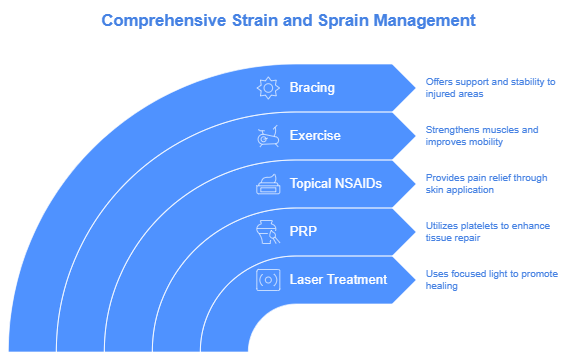Latest research on optimal treatment methods for strains and sprains.

Traditional Methods with a Modern Twist
While innovative technologies are emerging, traditional methods still play a crucial role in recovery:
RICE Method: The Rest, Ice, Compression, and Elevation (RICE) technique remains a fundamental approach to initial treatment for sprains and strains. [1]
Physical Therapy: Customized physical therapy programs continue to be essential for rehabilitation, focusing on:
- Strengthening exercises
- Flexibility training
- Proprioception improvement
Gradual Progression: Recent research emphasizes the importance of gradually increasing exercise intensity and duration to prevent re-injury during the recovery process. [2]
High-Intensity Interval Training (HIIT)
A 2023 study compared HIIT with traditional rehabilitation programs for musculoskeletal injuries. The HIIT group demonstrated superior outcomes, including:
- Greater reduction in pain levels (mean VAS score decrease of 5.2 vs. 3.8 for traditional rehabilitation, p< 0.05)
- Improved functional outcomes
- Faster recovery times [3]
Preventive Measures
Prevention is increasingly recognized as a critical aspect of injury management. Recent studies have identified several key preventive strategies:
- Proper warm-up routines
- Adequate rest and recovery between training sessions
- Use of appropriate protective equipment
- Improving overall fitness and strength [2,3]
Functional Training
A study on soccer players with ankle sprains found that functional rehabilitation training can improve ankle performance after a sprain. This approach showed better results in ankle instability assessment questionnaires and agility tests compared to traditional rehabilitation methods (P<0.05). [4]
Immersive Virtual Reality (IVR)
A recent protocol for a randomized control trial proposes using IVR in conjunction with conventional physiotherapy for lateral ankle sprains in futsal players. This innovative approach aims to improve static balance, dynamic balance, and vertical jump performance. [5]
Multidisciplinary Approach
The latest research suggests that a comprehensive, multidisciplinary approach yields the best results for sprain and strain recovery. This includes:
- Medical evaluation and treatment
- Physical therapy
- Strength and conditioning
- Nutritional support
- Psychological counseling when necessary

By addressing all aspects of an athlete's health and well-being, this approach aims to facilitate a faster and more complete recovery while reducing the risk of re-injury. [3] In conclusion, while traditional methods like RICE and physical therapy remain important, the integration of new technologies and a more holistic approach to recovery are shaping the future of sprain and strain rehabilitation. The focus is increasingly on personalized, comprehensive care that not only treats the immediate injury but also aims to prevent future occurrences.

References
- Hootman JM. The laser-assisted capsular shift procedure on an intercollegiate volleyball player: a case report. J Athl Train. 1999;34(4):368-372.
- Hootman JM. The laser-assisted capsular shift procedure on an intercollegiate volleyball player: a case report. J Athl Train. 1999;34(4):368-372.
- Comparative analysis of high-intensity interval training and traditional rehabilitation programs for accelerated recovery from musculoskeletal injuries. Published November 9, 2023. Accessed November 8, 2024.
- Functional training on ankle sprain rehabilitation in soccer players. Accessed November 8, 2024.
- Effect of Immersive Virtual Reality in Adjunct to Conventional Physiotherapy on Static Balance, Dynamic Balance and Vertical Jump in Futsal Players with Lateral Ankle Sprain: A Protocol for Randomized Control Trial. Published June 12, 2024. Accessed November 8, 2024.
Frequently Asked Questions (FAQ) on Sprain and Strain Recovery
Q: What is the RICE method, and is it still recommended?
A: The RICE method stands for Rest, Ice, Compression, and Elevation. It remains a fundamental approach for initial treatment of sprains and strains. However, recent research suggests it should be part of a more comprehensive recovery plan.
Q: How effective is physical therapy for recovering from sprains and strains?
A: Physical therapy continues to be essential for rehabilitation. Customized programs focusing on strengthening exercises, flexibility training, and proprioception improvement have shown significant benefits in recovery.
Q: Are there any new approaches to rehabilitation for sprains and strains?
A: Yes, recent studies have shown promising results with High-Intensity Interval Training (HIIT). A 2023 study found that HIIT led to greater pain reduction and faster recovery times compared to traditional rehabilitation programs.
Q: What preventive measures can I take to avoid sprains and strains?
A: Recent research emphasizes several key preventive strategies:
- Proper warm-up routines
- Adequate rest and recovery between training sessions
- Use of appropriate protective equipment
- Improving overall fitness and strength
Q: What is functional training, and how does it help in recovery?
A: Functional training focuses on exercises that mimic real-life movements. A study on soccer players with ankle sprains found that functional rehabilitation training improved ankle performance and stability more effectively than traditional methods.
Q: Are there any technological innovations being used in sprain and strain recovery?
A: Yes, a recent protocol proposes using Immersive Virtual Reality (IVR) in conjunction with conventional physiotherapy for lateral ankle sprains. This approach aims to improve balance and jump performance.
Q: What does a multidisciplinary approach to recovery involve?
A: A multidisciplinary approach includes medical evaluation and treatment, physical therapy, strength and conditioning, nutritional support, and psychological counseling when necessary. This comprehensive strategy aims to address all aspects of an athlete's health and well-being.
Q: How important is gradual progression in the recovery process?
A: Gradual progression is crucial. Recent research emphasizes the importance of slowly increasing exercise intensity and duration to prevent re-injury during the recovery process.
Q: Can nutrition play a role in recovering from sprains and strains?
A: Yes, nutritional support is considered part of a comprehensive recovery approach. Proper nutrition can aid in tissue repair and overall healing.
Q: How long does it typically take to recover from a sprain or strain?
A: Recovery time varies depending on the severity of the injury and the individual's adherence to the rehabilitation program. However, with proper care and following the latest recovery methods, many people see significant improvement within 4-6 weeks.
